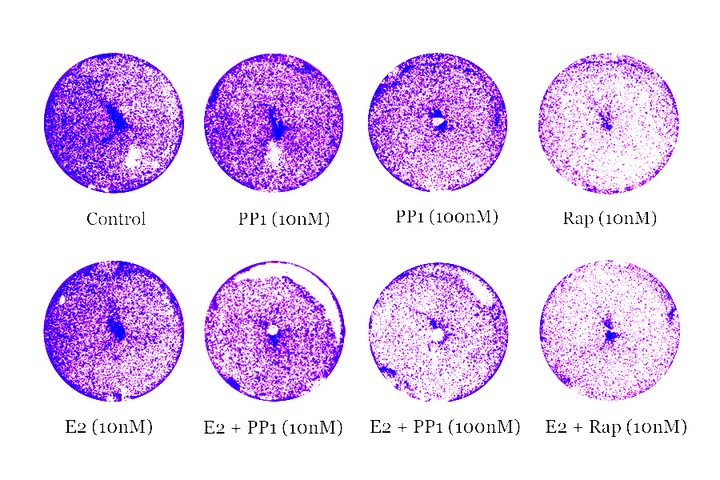Understanding the Molecular Significance of c-Src and mTor in Estrogen Mediated Breast Cancer Proliferation – an Invitro Study
 colonies of MCF-7 cells formed when treated with E2 (10nM), c-Src inhibitor PP1 (10nM and 100nM) and mTOR inhibitor rapamycin (10nM)
colonies of MCF-7 cells formed when treated with E2 (10nM), c-Src inhibitor PP1 (10nM and 100nM) and mTOR inhibitor rapamycin (10nM)
Estrogen plays a major role through transcriptional regulation of its target genes. 17β-Estradiol, the predominant circulating estrogen, is known to be a major causative factor in the tumorigenesis of breast cancer. It acts on its target cells through genomic or non-genomic pathway, both involving binding of estrogen to estrogen receptor (ER). Invitro studies using MCF-7 (ER +ve, breast cancer cells) have shown that estrogen independently cannot activate the proliferation of serum starved MCF-7 cells, unless supplemented with certain growth factors like IGF, EGF, etc. Therefore the study attempts to understand the exact role of estrogen in modulating the transcriptional activity of c-Src and mTOR. MCF-7 cells showed increased proliferation rate in mitogenic response to 17β Estradiol (10 nM). To understand the role of non-genomic adaptor proteins in E2 mediated breast cancer proliferation, MCF7 cells were treated with c-Src inhibitor PP1 (10, 100 nM) in the presence and absence of E2. Interestingly, we observed a suppression of cell proliferation in PP1 treated cells whereas addition of E2 increased cell proliferation in a time dependent manner. mTOR inhibitor rapamycin (10nM) alone enhanced cell proliferation whereas in the presence of E2, a suppression in cell growth was observed, coinciding with the 3-H thymidine uptake assay. To understand further, downstream of E2 responsive genes (pS2 and WISP-2) were studied using RT-PCR. GAPDH was used as loading control. Western blot analysis of cell cycle markers such as Cyclin D3, Cyclin E, Cyclin dependent kinases (CDK 2 and 4) and E2F revealed that the inhibition of proliferation is not due to cell cycle arrest. β-actin was used as a loading control. Long term effect on cell proliferation was also studied using colony formation assay. Conclusively all these results show that c-Src is active only when stimulated by liganded estrogen receptor (ER). The same is the case with the rapamycin. These results help to understand insights about c-Src and mTOR and in development of effective drugs against estrogen positive breast cancer.